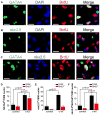Bone marrow-derived cell therapy stimulates endogenous cardiomyocyte progenitors and promotes cardiac repair
- PMID: 21474103
- PMCID: PMC4148018
- DOI: 10.1016/j.stem.2011.02.002
Bone marrow-derived cell therapy stimulates endogenous cardiomyocyte progenitors and promotes cardiac repair
Erratum in
- Cell Stem Cell. 2015 Jul 2;17(1):125
Abstract
Cell therapy can improve cardiac function in animals and humans after injury, but the mechanism is unclear. We performed cell therapy experiments in genetically engineered mice that permanently express green fluorescent protein (GFP) only in cardiomyocytes after a pulse of 4-OH-tamoxifen. Myocardial infarction diluted the GFP(+) cardiomyocyte pool, indicating refreshment by non-GFP(+) progenitors. Cell therapy with bone marrow-derived c-kit(+) cells, but not mesenchymal stem cells, further diluted the GFP(+) pool, consistent with c-kit(+) cell-mediated augmentation of cardiomyocyte progenitor activity. This effect could not be explained by transdifferentiation to cardiomyocytes by exogenously delivered c-kit(+) cells or by cell fusion. Therapy with c-kit(+) cells but not mesenchymal stem cells improved cardiac function. These findings suggest that stimulation of endogenous cardiogenic progenitor activity is a critical mechanism of cardiac cell therapy.
Copyright © 2011 Elsevier Inc. All rights reserved.
Figures





Comment in
-
A repair "kit" for the infarcted heart.Cell Stem Cell. 2011 Apr 8;8(4):350-2. doi: 10.1016/j.stem.2011.03.005. Cell Stem Cell. 2011. PMID: 21474095 Free PMC article.
Similar articles
-
Stem cell factor gene transfer promotes cardiac repair after myocardial infarction via in situ recruitment and expansion of c-kit+ cells.Circ Res. 2012 Nov 9;111(11):1434-45. doi: 10.1161/CIRCRESAHA.111.263830. Epub 2012 Aug 29. Circ Res. 2012. PMID: 22931954 Free PMC article.
-
Preinduction with bone morphogenetic protein-2 enhances cardiomyogenic differentiation of c-kit+ mesenchymal stem cells and repair of infarcted myocardium.Int J Cardiol. 2018 Aug 15;265:173-180. doi: 10.1016/j.ijcard.2018.01.134. Int J Cardiol. 2018. PMID: 29885685
-
Membrane estrogen receptor alpha is an important modulator of bone marrow C-Kit+ cells mediated cardiac repair after myocardial infarction.Int J Clin Exp Pathol. 2015 May 1;8(5):4284-95. eCollection 2015. Int J Clin Exp Pathol. 2015. PMID: 26191121 Free PMC article.
-
"String theory" of c-kit(pos) cardiac cells: a new paradigm regarding the nature of these cells that may reconcile apparently discrepant results.Circ Res. 2015 Mar 27;116(7):1216-30. doi: 10.1161/CIRCRESAHA.116.305557. Circ Res. 2015. PMID: 25814683 Free PMC article. Review.
-
An overview of the myocardial regeneration potential of cardiac c-Kit+ progenitor cells via PI3K and MAPK signaling pathways.Future Cardiol. 2020 May;16(3):199-209. doi: 10.2217/fca-2018-0049. Epub 2020 Mar 3. Future Cardiol. 2020. PMID: 32125173 Review.
Cited by
-
Leukemia Inhibitory Factor Enhances Endogenous Cardiomyocyte Regeneration after Myocardial Infarction.PLoS One. 2016 May 26;11(5):e0156562. doi: 10.1371/journal.pone.0156562. eCollection 2016. PLoS One. 2016. PMID: 27227407 Free PMC article.
-
Cardiac stem cell therapy: Have we put too much hype in which cell type to use?Heart Fail Rev. 2015 Sep;20(5):613-9. doi: 10.1007/s10741-015-9494-7. Heart Fail Rev. 2015. PMID: 26024953 Review.
-
Fetal myocardium in the kidney capsule: an in vivo model of repopulation of myocytes by bone marrow cells.PLoS One. 2012;7(2):e31099. doi: 10.1371/journal.pone.0031099. Epub 2012 Feb 23. PLoS One. 2012. PMID: 22383995 Free PMC article.
-
Cardiomyocyte proliferation and progenitor cell recruitment underlie therapeutic regeneration after myocardial infarction in the adult mouse heart.EMBO Mol Med. 2013 Feb;5(2):191-209. doi: 10.1002/emmm.201201737. Epub 2013 Jan 29. EMBO Mol Med. 2013. PMID: 23255322 Free PMC article.
-
A New Paradigm in Cardiac Regeneration: The Mesenchymal Stem Cell Secretome.Stem Cells Int. 2015;2015:765846. doi: 10.1155/2015/765846. Epub 2015 May 5. Stem Cells Int. 2015. PMID: 26074978 Free PMC article. Review.
References
-
- Abdel-Latif A, Bolli R, Tleyjeh IM, Montori VM, Perin EC, Hornung CA, Zuba-Surma EK, Al-Mallah M, Dawn B. Adult bone marrow-derived cells for cardiac repair: A systematic review and meta-analysis. Arch Intern Med. 2007;167:989–997. - PubMed
-
- Balsam LB, Wagers AJ, Christensen JL, Kofidis T, Weissman IL, Robbins RC. Haematopoietic stem cells adopt mature haematopoietic fates in ischaemic myocardium. Nature. 2004;428:668–673. - PubMed
-
- Beltrami AP, Barlucchi L, Torella D, Baker M, Limana F, Chimenti S, Kasahara H, Rota M, Musso E, Urbanek K, et al. Adult cardiac stem cells are multipotent and support myocardial regeneration. Cell. 2003;114:763–776. - PubMed
-
- Beltrami AP, Cesselli D, Bergamin N, Marcon P, Rigo S, Puppato E, D’Aurizio F, Verardo R, Piazza S, Pignatelli A, et al. Multipotent cells can be generated in vitro from several adult human organs (heart, liver, and bone marrow) Blood. 2007;110:3438–3446. - PubMed
Publication types
MeSH terms
Substances
Grants and funding
LinkOut - more resources
Full Text Sources
Other Literature Sources
Medical
Molecular Biology Databases

